This Lake Como Stay Is One of the Top New Hotels in the World — and It's the Best Family Vacation We've Ever Taken
Passalacqua, one of Italy's most luxurious new hotels, is the perfect place for a relaxing (and over-the-top) family getaway.
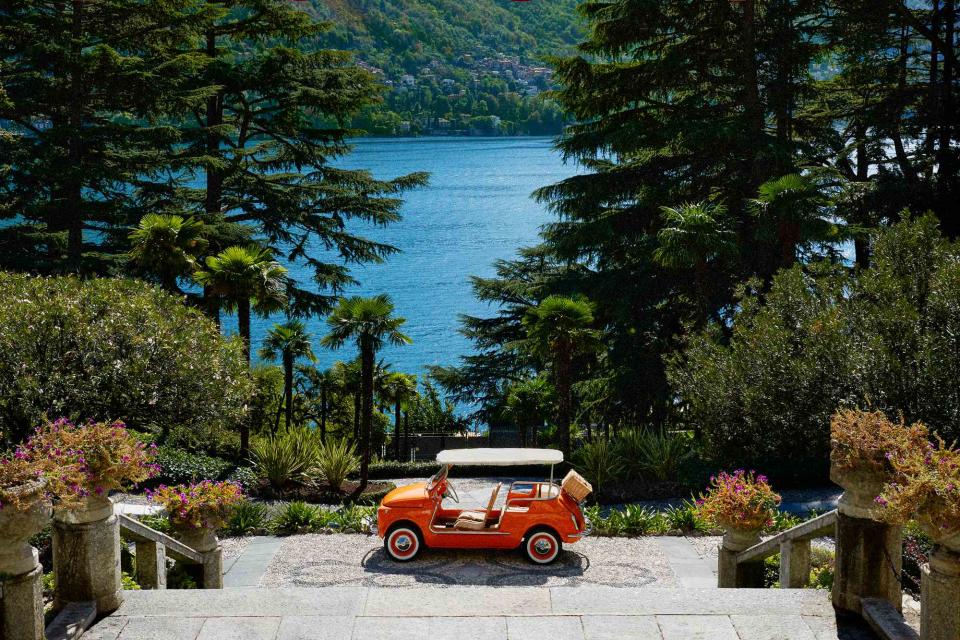
Danilo Scarpati
A customized Fiat 500 at Hotel Passalacqua, on Lake Como.It's the green of the water that gets you: a deep well of color that, at first sight, gives you the impression that you’ve hit upon the secret source of all greens. In the shallower parts of Lake Como, the water is like some health-giving broth. Open your eyes underwater and you’re swimming around in a wine bottle. In the middle, the water is thick and glossy, like emulsion paint. You can almost imagine a celestial brush swooping down from the hills surrounding the lake, filling its bristles and covering some distant valley. So much more elegant than the turquoise bays and lagoons you see on Instagram.… They should really make sunglasses with lenses the color of the Italian lakes.
Please forgive my sun-lounger musings; Lake Como does this to you. And there are few better spots for greenish contemplations than the pool terrace at Passalacqua, a 24-suite hotel set amid seven acres of terraced gardens that opened last summer on the lake’s southwestern shore.
My wife, Johanna, our two sons, and I were subject to a few days of opulence there last September, when the golden, late-summer light, with its slight yet bracing hint of fall, felt well suited to the place’s stately mood. Passalacqua had a miraculous effect on our boys, too. Normally Aubrey, the two-year-old, likes to spend his time shouting and throwing things. But after a bit of splashing around in the dreamy hotel pool, he too fell into a state of contemplation, drifting around in his water wings for long stretches, just gazing at the mountains. I’ve never seen him so calm.
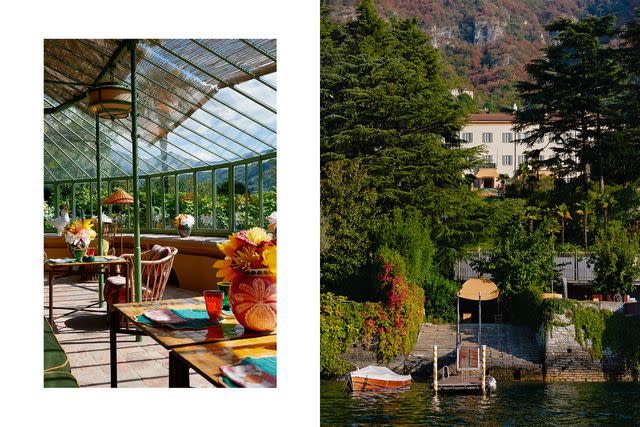
Danilo Scarpati
From left: The conservatory at Passalacqua, with its interiors by designer du jour J. J. Martin; Passalacqua, as seen from Lake Como.Lake Como, an upside-down Y set in the Alpine foothills of north Lombardy, is Italy’s deepest body of water and its third largest. It has long been one of those exclusive, understated destinations — perennially fashionable, but never reaching the saturation point of, say, Venice or Capri. Virgil called it “our greatest lake.” Pliny the Younger owned a pair of villas there, named Comedy and Tragedy. Mussolini had the good taste to be shot on the eastern shore in 1945. The views are “unequaled on earth for loveliness,” reflects Countess Pietranera in Stendhal’s novel "The Charterhouse of Parma." The evergreen hills rising up from the water “have not yet been ruined, and forced to bring in an income, by the hand of man,” she goes on. “Nothing recalls the hideousness of civilization.”
Related: 12 Best Small Towns in Italy
Notwithstanding a few signs of the times — seaplanes landing on the water, a tunnel being bored through the mountains to bring in a new highway for the 2026 Milan-Cortina Winter Olympics — you can still see what the countess was getting at. The mood is classy, never flashy. Only a handful of Russian oligarchs bought property on the lake, and when war broke out in Ukraine, their mansions were seized. The villas are protected by stringent preservation orders and most remain Italian-owned; the exceptions tend to belong to low-key Italophiles (a certain Signor George Clooney springs to mind). Though tour groups descend on the nearby villages of Bellagio, Cernobbio, and Varenna in high season, Lake Como has no main drag or beach or central piazza for visitors to congregate around, and thus an air of well-heeled discretion pervades.
Lake Como, an upside-down Y set in the Alpine foothills of north Lombardy, is Italy’s deepest body of water and its third largest. It has long been one of those exclusive, understated destinations — perennially fashionable, but never reaching the saturation point of, say, Venice or Capri.
Still, tourist numbers have been climbing for more than a decade — hence the new tunnel — and Como experienced a mini boom in the summer of 2022, when three years’ worth of postponed COVID-era weddings filled the villas and hotels with guests and the evening skies with fireworks. Como has also acquired newfound “it” status, thanks in large part to the vision of lake life honed by the De Santis family, who own Passalacqua and Grand Hotel Tremezzo, a magnificent Belle Époque institution in what’s known as the mid-lake, right on the fork of the Y. The hotels are, apparently, two of the only places on the lake that Clooney will send his houseguests for meals. This starry vibe was affirmed when we arrived at Passalacqua and learned that Ben Affleck and Jennifer Lopez had just finished up a honeymoon lunch at a plum table overlooking the water.
The Passalacqua Villa had long been considered one of the area’s most fetching private homes. Most of the current property was built by Count Andrea Lucini Passalacqua in 1787, to a design by the architect Carlo Felice Soave; it features a grand central staircase and frescoes by the Neoclassical painter Andrea Appiani. Napoleon Bonaparte and Winston Churchill have been among its many notable guests, as well as the composer Vincenzo Bellini, who wrote his operas Norma and La Sonnambula in what is now the vast, double-height Bellini Suite. (There is a grand piano in the room, should inspiration strike.) Many of the hotel’s 23 other suites are named after Bellini heroines, and in each one, there’s a little dial you can use to turn his arias up, down, or off — although one night, I inadvertently hacked into the Bluetooth interface and blasted the entire hotel with Kate Bush’s “Running up That Hill.”
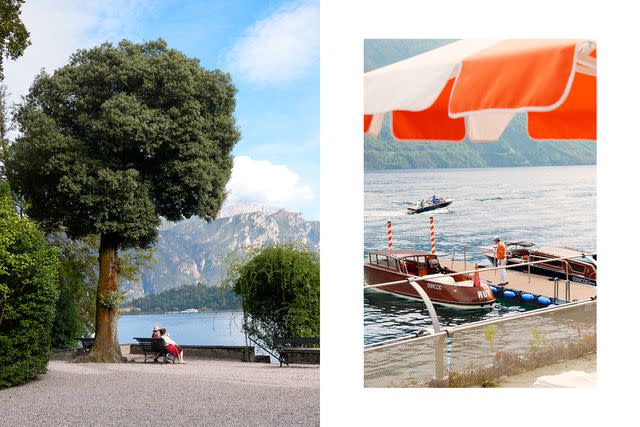
Danilo Scarpati
From left: Taking in the views from Villa Carlotta, a botanical garden and museum near Grand Hotel Tremezzo; the dock at Grand Hotel Tremezzo, which opened in 1910.After the original family left in 1885, the house was owned first by a Swedish baroness and then by a European pseudoscientist, who spent much of the 1970s advancing a theory that humans are descended from cannibalistic brain-eating monkeys. Its most recent resident was an American investment banker, James Cantwell, who put it up for auction in 2018. The winning bidders were the De Santis family, who reportedly spent upwards of $100 million, plus a further $22 million on improvements. Milan-based designer du jour J. J. Martin was brought in to conduct a maximalist redo of the pool and bar area, and an adorable orange Fiat 500 was positioned between the villa and the waterfront — both of which have been notable hits on social media.
The hotel’s vibe is more Succession — albeit with a distinctly Italian sprezzatura.
There are now 12 suites in the main house, eight more, plus a spa, in a building behind the main villa, and four more in the newly refurbished Casa al Lago, which is closer to the shore and can be rented out separately. The terraced gardens include a tennis court, a rose garden, an orchard, a handsome flock of chickens, and many mature cedar, orange, and magnolia trees.
Turning the place into a hotel that feels both classic and of-the-moment has been a mission for Valentina De Santis, whose grandparents have owned the Grand Hotel Tremezzo since the 1970s. Over cocktails and fresh arancini on the terrace one evening, she described how work had come to an abrupt standstill in the spring of 2020, six months into the renovations, when the pandemic arrived in Italy. “Ninety-nine percent of the things we used in the villa were sourced in Italy, and nobody was working,” she said. “It was such a black time.”
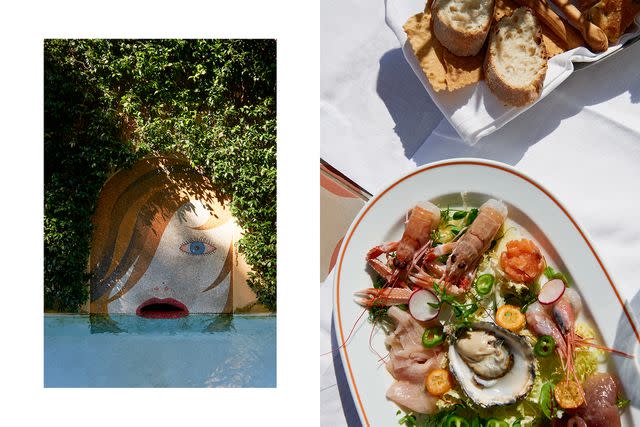
Danilo Scarpati
From left: Grand Hotel Tremezzoâs Happiness Fountain, designed by Modernist architect Ico Parisi; mixed seafood at its most photogenic in the restaurant of Grand Hotel Tremezzo.The pause did, however, give De Santis time to obsess over the details. When she came down with COVID, she spent a week in her bedroom, choosing which of more than 200 different Rubelli fabrics should be combined in each room — the sort of task she would never normally have had time to do. Living near the villa, she found that her vision evolved. “We fell in love with this place more and more,” she said. “We lost the idea that it was a hotel and started to work on it as if it were our family home.”
For many of us, the words family home will conjure visions of discarded wet wipes, half-finished homework, and Cheerios trodden underfoot. The hotel’s vibe is more Succession — albeit with a distinctly Italian sprezzatura. There are colossal handblown chandeliers by Murano glass specialists Barovier & Toso, designed to refract the sunlight by day and mimic the softness of candlelight at night. There are ingenious bespoke trunks by leather artisan Bottega Conticelli at the foot of each bed, from which flat-screen TVs emerge, James Bondishly, at the touch of a button. There is marble everywhere, in every shade; numerous salons where you can recline with a book; an on-site florist who prepares fresh posies for each new guest; and two vintage speedboats bobbing on the lake that you might be tempted to propose to. Unadvertised, there is also an incredible array of underground tunnels, used to ferry supplies from the lakeshore to the kitchens back in the 18th century. You might just be allowed to explore them, if you ask nicely.
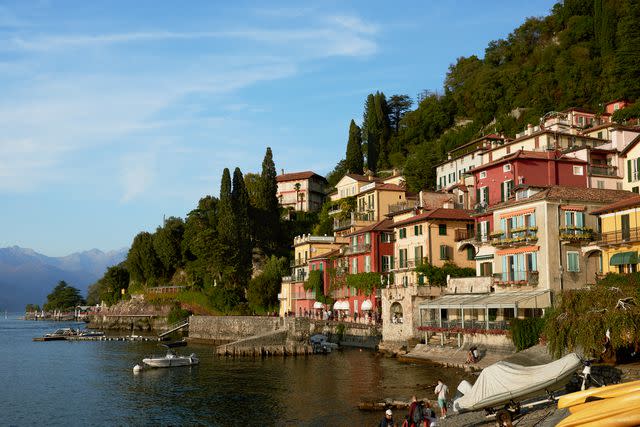
Danilo Scarpati
Varenna, one of the prettiest of the villages that line Lake Como.My family was put up in the aforementioned Sala Bellini: dreamlike, shimmering, large enough to accommodate several concurrent games of badminton. It immediately rendered all future vacations bitterly disappointing. I will cherish for a long time the sensation of falling asleep on one of its many deep sofas early one evening and waking to glimpse a buttery half-moon through a high window.
We learned to appreciate the subtle difference between looking at a neoclassical fresco of the Three Graces in a public museum and having three muses looking at us as we threw on our swimming things or tried to feed Aubrey a banana. One of the first things we had to do, upon arrival in our room, was request that four Chinese vases be removed. We could just see Aubrey and our eight-year-old, Teddy, careering into one of them as they ran around playing hide-and-seek.
More Trip Ideas: This Under-the-radar Italian Island Offers Gin-clear Waters, White-sand Beaches, and Postcard-perfect Villages
Children are, in fact, very welcome at Passalacqua — just not always by their parents, who would sometimes appreciate a minute to enjoy their glass of Franciacorta in peace. But actually, once those vases were safely removed, all four of us unspooled. Teddy loved the pool, the tennis court, and the wonderfully ornate copper pot from which his hot chocolate was poured at breakfast time. He also rather took to the grand piano in our room; I like to think his improvisations took on a Neoclassical tinge over the course of our stay. Aubrey, meanwhile, enjoyed clambering on the tiny orange Fiat, pestering us for the silver candy from the bowl at reception, and chasing the flock of chickens around their little enclosure.
You could do a lot worse than to hire a car or, better, a bicycle and spend a week exploring these tucked-away little spots. I think you could work through most of the major ice cream flavors in that time.
So, yes, while the place feels designed to dumbfound, it also feels more akin to staying at a grand house from a 19th-century novel than a hotel. The lounges are places you might actually want to read a book. The kitchen is open, so you can wander in and help yourself to a slice of that zucchini flan you didn’t quite have room for at breakfast. Indeed, the head chef, Mauro Verza, was recruited from a wealthy Milanese family, as opposed to a restaurant or hotel. His menus feature things like lobster salad with melon, veal Milanese, vanilla risotto. It’s domestic cooking done with refinement.
De Santis told me one of her favorite dishes is spaghetti al pomodoro, pasta with a simple tomato sauce that you will find in every Italian home, but which Verza lifts to new heights with lemon zest and goat cheese. We were making our way through plates of this while eating dinner under a canopy outside when a spectacular electrical storm blasted the Grigne mountains on the other side of the lake. We stuck it out until our secondi, before taking pity on the waiters ferrying plates back and forth in the pouring rain. We retired inside for zabaglione, that wonderfully old-school boozy custard dessert.

Danilo Scarpati
From left: Grand Hotel Tremezzoâs Happiness Fountain, designed by Modernist architect Ico Parisi; mixed seafood at its most photogenic in the restaurant of Grand Hotel Tremezzo.After three nights of this hell, we drove 14 miles up the coast to the De Santis family’s original project, the far larger Grand Hotel Tremezzo. Built in 1910, this 84-room property was one of the first of the grand hotels on the lake. Valentina De Santis told me she spent her childhood summers getting under everyone’s feet behind the reception desk watching all the comings and goings, and certainly, it’s the sort of place that would give you a lifelong love of hotels. The whole thing runs like a Swiss watch.
Notable features include jaunty orange awnings, a pool that floats on the lake, an artificial beach with a seafood restaurant, and a staff straight from a Wes Anderson movie. Modernized in 2014, it is nevertheless still reminiscent of an age when Russian princesses, French ballerinas, and Prussian generals would turn up and stay the whole summer — and perhaps the winter, too, when the lake heaved with skaters.
Related: The Ultimate Italy Packing List
Grand Hotel Tremezzo is a good base for exploring, as it’s situated at the midsection of the lake, where its three branches meet. It’s next door to Villa Carlotta, an imposing 17th-century building that contains many fine Antonio Canova sculptures and has extensive botanical gardens. It’s also across the water from Bellagio, long renowned as the lake’s most picturesque village. On a late-summer Sunday afternoon, however, we found the experience of catching the public ferry just a little maddening and Bellagio slightly overrun with tour groups and (worse) tourist menus. Far more charming was Varenna, a hop up the coast, with its colorful houses, and a milky-white waterfall known as the Fiumelatte, which was admired by Leonardo da Vinci.
As postcard-pretty as this was, however, I preferred the understated charms of Moltrasio, a short walk up from Passalacqua. On a bend in the road is the main square — triangle, actually — which contains a statue of Bellini, a first-rate gelateria, an extremely well appointed church, and a bar perched on the bend, affording a spectacular view. All the essentials of Italian life, really. You could do a lot worse than to hire a car or, better, a bicycle and spend a week exploring these tucked-away little spots. I think you could work through most of the major ice cream flavors in that time.
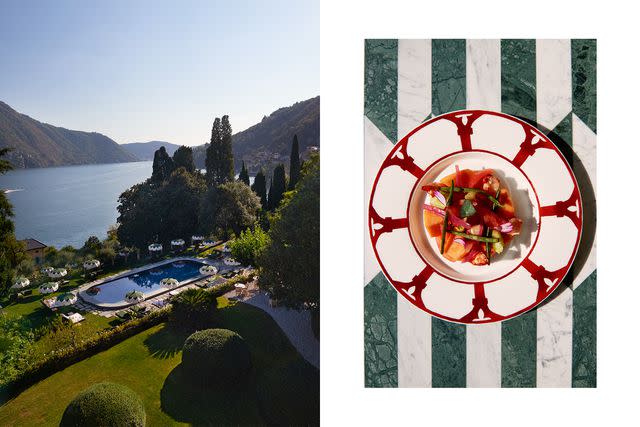
Danilo Scarpati
From left: The pool at Passalacqua, a historic Lake Como villa recently converted into a hotel; a lunch of lobster salad with melon at Passalacqua.It is also very much worth lingering in the city of Como, the lake’s largest population center, on the southwesternmost tip. It tends to feature on itineraries more as an interchange than as a destination (there are frequent fast trains to Milan), but I found the place all the more appealing for its lived-in feel. We spent our last couple of nights at the Hilton. It was a little businesslike, as you’d expect, but it did have a fabulous rooftop pool that wasn’t always overrun with Englishmen drinking beer. The walk into town from there is known as the Passeggiata Lino Gelpi. You pass a succession of villas, the Como Aero Club and its hangar of seaplanes, the Yacht Club, the football stadium, and a monument to Italy’s World War II dead, before arriving at a well kept municipal park with carnival rides for children and a cheerful outdoor café for grown-ups.
In the town itself is the historic Teatro Sociale opera house, where the company from La Scala occasionally performs, and a breathtaking, bat-filled Duomo in the main square, where you will also find a first-rate restaurant, Da Pietro — no menù turistico in sight. There was even a book festival going on while we were there, which added to a Mitteleuropean air of health and culture. Over a final round of gelati on a bench by the harbor, we concluded that Stendhal’s countess may have had it all wrong.
Civilization — it’s not so bad after all.
Lake Como’s Best Hotels
Grand Hotel Tremezzo: An iconic Art Nouveau palace with a private beach on Lake Como’s western shore. The 84 rooms and suites have views of the town of Bellagio and the Grigne mountains.
Grand Hotel Villa Serbelloni: A 150-year-old hotel set in a Neoclassical villa in the town of Bellagio, with expansive gardens and views of the lake, antique Murano glass chandeliers, and original frescoes.
Hilton Lake Como: Previously a silk factory, this 170-room property in the city of Como has a rooftop pool, a spa, and a fleet of bikes available for guests to borrow.
Il Sereno Hotel: Designed by acclaimed Spanish architect Patricia Urquiola, this contemporary property has 40 spacious suites, a full-service spa, and a 60-foot infinity pool overlooking the lake.
Mandarin Oriental, Lake Como: Located in a centuries-old botanical park on the eastern shore of the lake, with 75 guest rooms, suites, and private villas spread discreetly across nine buildings.
Passalacqua: This 18th-century villa was recently converted into the hottest property on the lake, with 24 exquisite suites, terraced gardens, and an Instagram-famous swimming pool overlooking the water.
Villa d’Este: With 152 rooms and suites set in a waterfront Renaissance palace, this Cernobbio classic has hosted celebrities from Frank Sinatra to Jennifer Aniston.
A version of this story first appeared in the June 2023 ssue of Travel + Leisure under the headline "Acqua Di Vita."
For more Travel & Leisure news, make sure to sign up for our newsletter!
Read the original article on Travel & Leisure.

